How to Cite | Publication History | PlumX Article Matrix
Information Provision of Patent Research
Anastasia M. Tolstaya, Irina V. Suslina and Polina M. Tolstaya
National Research Nuclear University MEPhI (Moscow Engineering Physics Institute), Kashirskoe highway 31, 115409, Moscow, Russian Federation.
Corresponding Author E-mail: tolstaya.a@inbox.ru
DOI : http://dx.doi.org/10.13005/bbra/2291
ABSTRACT: This research deals with the information provision of patent research of scientific and technical achievements. The study focuses on the concert of patent research, It purposes; the concept of patent information sources, their characteristics. The paper provides the analysis of several patent and non-patent databases, reveals their main features and assess the completeness of the information provided by various information retrieval resource. Recommendations on the choice of the search databases are given. A thematic search on wireless capsule endoscopy using patent and non-patent databases available on the Internet was carried out. It was concluded that to obtain the most complete picture, the patent research should be conducted using both patent and non-patent information retrieval resource. The results of the research can be useful to carry out a patent research in order to increase the efficiency of commercialization process of the intellectual activity results in bringing goods into the international market.
KEYWORDS: patent database; non-patent database; patent research; patent search; information retrieval system
Download this article as:| Copy the following to cite this article: Tolstaya A. M, Suslina I. V, Tolstaya M. P. Information Provision of Patent Research. Biosci Biotech Res Asia 2016;13(3) |
| Copy the following to cite this URL: Tolstaya A. M, Suslina I. V, Tolstaya M. P. Information Provision of Patent Research. Biosci Biotech Res Asia 2016;13(3). Available from: https://www.biotech-asia.org/?p=15468 |
Introduction
Now a days the value of intellectual property has greatly increased. New ideas in various fields of knowledge lead to the development of science and technology, improvement of the standard of living in the country, its defensive potentialities, etc. The state of intellectual property of the country can identify the state of the economic, cultural, social, etc. development of the state.
It is worth noting that in order to protect the idea by the state, it should be patentable. The legislation of many countries sets criteria for patentability of inventions, utility models and design inventions, one of which is the novelty. The novelty of the various objects of the patent law can be defined in different ways, but generally, it is just search forana logs.
Another important aspect of patent research is economic one. It is worth patenting a new invention providing it is profitable for the rights possessor. Patent research implies market research of the product of interest and the conditions of its implementation, identificationof key customers and their needs, analysis of the competitiveness of the invention, findingpotential partners, identification of the best scientific and technological gains in the industry, etc.
Search for analogs can be carried out by using a variety of information resources: scientific articles, search engines, books, the Internet, and others. It is worth noting that one invention can have a large number of related documents, so it is essential to conduct information searches, involving the greatest number of relevant and credible information.
According to the World Intellectual Property Organization’s (WIPO)statistics, each year the number of patent applications filed in various patent offices around the worldincreases (Figure 1) [1], consequently,the number of documents that shall be analyzed before admitting results of intellectual activity patentable increases every day.
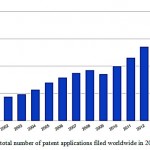 |
Figure 1: The total number of patent applications filed worldwide in 2000-2014. |
In the field of patent law for the search for analogs specialized information retrieval resources containing content-date information on existing inventions, utility models and design inventions are often used.
The data used for search can be divided in two groups: patent and non-patent information.
The patent information is commonly an information about inventions, utility models, industrial designs and trademarks declared as objects of industrial property and/or officially recognized as such by the patent office. Patent information contains scientific and technical information as well as information on the legal status of protected sites and its subsequent changes, authors, applicants and owners, the transfer of intellectual property rights and others. [2]
Non-patent information may include scientific papers, books, scientific, technical and economic reports, design documents, etc.
Choosing the right patent and non-patent documentation can save money on own research and development and avoid duplication. It allows to get license for inventions of interest and find partners willing to cooperate on mutually beneficial terms (patent information can be used to analyze inventive activity of the enterprise) as well as to determine the competitors, their strengths and weaknesses.
Nowadays in the world,there are lots of patent databases and resources, providing access to them. They differ in the number of patent documents, completeness of information, additional analytical potential and access type to the database/resource.
Information about patent databases, in addition to the official sites of the information-retrieval resources, can be found on Internet portals, such as [3-5] and in articles[6]. However, such resources often contain only links to various databases with a brief description of their contents.
Another useful information source is the Patent Search System [7]– atool allowing side-by-side comparison of the patent search systems that have been reviewed by the Intellogist team. Patent Search System contains legal information about the organization that created the database, based on the reviews, data on the amount covered by the patent information, patent family, quoting, classifications, patent status and other information related to the search of patent documents. However, this resource provides only general information about the usability of patent databases.
Moreover, the use of sources of non-patent information when conducting a patent search is still a topical issue, as they are often less known and available and are ignored by researchers in connection with their alleged insignificance.
So nowadays there is no resource providing systematized comparative information about patent and non-patent databased as well as recommendations for their choice that can ease the selection of the database for particular search topic.
Thus, classification and description of popular information retrieval resources containing patent and non-patent documents is relevant in terms of the completeness of the patent information to facilitate the work of developers of new products in order to increase the efficiency of the process of commercialization of the results of intellectual activity in the bringing of goods on the international market.
In this paper the most popular information retrieval resources containing patent documentation, in terms of completeness of patent information will be reviewed and compared. The paper also provides guidance on the use of the considered patent and non-patent databases. Using obtained data the patent research is conducted to prove the stated ideas.
The methodological basis for this research has been formed mainly by analyzing Federal Regulations on patent research, patent and non-patent databases, articles and publications on the topic, as well as by experts’ insight.
Patent Research
Patent research is a study of the technical level and trends of the objects of economic activity, their patentability, infringement, competitiveness (intended use efficiency) based on patent and other information. At the same time, patent research has an economic focus, which is to analyze the market of interest in order to assess product competitiveness.
Patent research is conducted on the basis of the analysis of sources of patent information with the involvement of other types of information (scientific, technical, economic and market), containing information about the latest scientific and technological achievements related to product development, state and prospects of the market of products of this type.[8]
The purposes of patent research are the study of the object`s state of art, trends identification, rational forecast of development, research of markets of interest, establish consumer needs and the requirements to the product, identification of advanced scientific and technological achievements, etc. [9]
The process of creating a new product can be divided into several stages, which differ in tasks and methods of their solutions
search for ideas
market analysis
analysis of production and marketing possibilities
development of terms of reference (TOR)
scientific research (R)
experimental development (D)
experimental batch
organization of mass production
The correlation of different types of patent research with the stages of a new product creation is shown in Table 1 [10].
Table 1: Correlation of different types of patent research with a new product creation stages.
| Types of patent research | Search for ideas | Market analysis | Analysis of production, marketing possibilities | TOR | R | D | Experimental batch | Organization of mass production |
| Determination of product requirements | + | + | ||||||
| The most effective scientific and technical data selection | + | + | + | + | ||||
| Technical level evaluation | + | + | + | + | ||||
| Analysis of art trends | + | + | + | |||||
| Analysis of competition | + | + | + | |||||
| Legal protection of new technical solutions | + | + | + | + | ||||
| Examination on patent clearance | + | + | + |
Before proceeding to the patent database search, it is necessary to correctly formulate a script (keywords) that provides the optimal ratio of completeness and accuracy of information found by the search system. To this end, the subject area of interest is divided into several technological areas, each of which are defined using keywords specific to the field of terms to define correctly the International Patent Classification (IPC). Otherwise, search in patent databases without correctly identified keywords is practically impossible. Keywords are also the selection criteria of relevant information for subsequent analysis.
For example, tells consider the search results using FreePatentsOnline.com database looking at the various requests and the number of documents found by the system (Table 2).
Table 2: Examples of requests.
| Request | Number of documents found (US patents) | Comments |
| bluetooth | 282076 | Search for documents containing the word «bluetooth». If the field is not specified by the user, the search is performed by all available fields |
| bluetooth AND wireless | 56002 | Search for documents containing both words «bluetooth» and «wireless» in one or several fields |
| TTL/bluetooth NOT wireless | 42 | Search for documents containing the word «bluetooth» in title, excluding documents, containing the word «wireless» in any field |
| «wireless device»
|
50636 | Search for documents containing the phrase «wireless device» |
| bluetooth^4 OR wireless | 417848 | Search for documents containing the words «bluetooth» or «wireless», but under otherwise equal conditions «bluetooth» is four times more important than «wireless». 4 can be replaced by any number |
| wire* | 1332958 | Search for documents containing the words starting with «wire», e.g.wires, wireless, wireside, wiretap, etc |
| ro? | 1601669 | Search for documents containing the words starting with «ro» but containing only three letters, e.g. rod, rot, rob, rog, etc |
| APD/01/01/2000 | 3 | Search for documents with application date 01/01/2000 |
| APD/01/01/2000->NOW | 2482609 | Search for documents with application date from 01/01/2000 till now |
Table 2 shows that the same words arranged in a script in a different order and with different syntax can greatly expand or narrow the number of patent documents found by the system, thereby affecting the accuracy of the picture of the current level of technology.Thus, work on patent research requires detailed preparation, clear understanding of what kind of information the researcher wants to find and precise formulation of assignment for patent research.
Patent Databases
Information technology can facilitate the work with patent information provided by patent databases. In recent years, the establishment of user-friendly search resources has received increasing attention. Some of the ideas are presented in[11-13]. Existing patent databases can be divided into two major groups – the database with free and paid access. Let us consider the most popular search resources with free access as they are used worldwide and can be easily accessed.
In this paper, we consider six popular patent databases: Espacenet, FreePatentsOnline, Google, The Lens (The Patent Lens), PATENTSCOPE, USPTO.
The evaluation parameters of patent information retrieval resources were chosen as follows
The number of patent documents included in database. This parameter shows the fullness of patent search and breadth of information covered by the researcher.
The volume of provided information about patent documents. Shows by which parts of a patent document the search is carried out: abstract, description, full text, etc.
Highlightingscript keywords. Facilitates visual analysis of patent document.
Information aboutthe patent application. Indicates the information completeness of each patent document provided by the patent database.
Types of search withinthe patent database
Additional system functions
These parameters are consideredas the most important when choosing the information retrieval resource, they because provide the most complete picture of the resource and the information contained therein, which ultimately affects the quality of patent research. [14]
For ease of comparison, the basic information about the above free information retrieval systems is represented in the form of tables (Tables 3 and 4).
Table 3: Brief information about popular information retrieval systems.
| Patent database | Developed by | Number of patent documents | Volume of information provided | Highlighting script keywords | Information about the patent document |
| Espacenet | European Patent Office | >80 mln | Full text (not for all documents) | In abstract and title by marker of the same color
|
Patent document number; publication date; name of the invention; inventors; applicants; classification; abstract; description (not for all documents); claims (not for all documents); figures; cited in patent application sources (not for all documents); legal status. |
| FreePatentsOnline | Patents Online LLC | >30 mln | Full text | In abstract, title, claims and description by markers of different colors | Name of the invention; patent application number; abstract; inventors; publication date; priority date; classification; International Classification; similar patent applications; claims; description; additional materials. |
| Google Inc. | n/d | In volume provided by patent offices, to which Google has access | In abstract, title, claims and description by marker of the same color | Name of the invention; publication number; abstract; claims; description; type of publication; application area; application number; publication date; declared; priority date; other patent numbers; publication number; inventors; applicant; other patents; non-patent documents; classification; legal events; external links (Patentscope, Espacenet). | |
| The Lens | Cambia | >85 mln | Full text | In abstract, title, claims and description by marker of the same color | Name of the invention; patent number; abstract; claims; full text (description); owners; applicants; inventors; publication date; IPC; US classification; document history (publication, patent applications, priority); patent family; non-patent citations / links; cited in; brief document preview; figures; legal information. |
| PATENTSCOPE | World Intellectual Property Organization | ≈33 mln | Full text | In abstract and title by marker of the same color
|
Name of the invention; publication number; international application number; abstract; publication date; international filing date; IPC; applicants; inventors; priority date; designated states; language of publication; language of filing; claims (in language of the applicant); description (in the language of the applicant); additional materials (including figures). |
| USPTO | United States Patent and Trademark Office | >5 mln | Full text | No | Number of patent document; publication date; name of the invention; abstract; inventors; applicants; application number; filing date; information about similar patent documents; cited in patent application sources; claims; description; drawings and figures. |
Table 4: Brief information about popular information retrieval systems (continuation).
| Patent data base | Type of search | Additional system functions |
| Espacenet | – Quick Search (by keyword, names of individuals or organizations);
– Advanced Search (using any of the available fields); – Number Search (by number of publication, application, priority date); – Classification ECLA (Patent Classification System of the European Patent Office). |
Sorting found documents by various fields of search
|
| Free Patents Online | – Quick Search (by application number or patent number; keywords; publication date or priority date; Classifier (US or IPC); inventor, his country, city, state; applicant, his country, city, state; legal, procedural information);
– Expert Search(by script that contains a special syntax, including the abbreviated names of the search fields provided in Quick Search section, as well as special symbols). |
Via paid resource AcclaimIP |
| – Quick Search (by keyword);
– Advanced Search (by words and phrases, patent number, title, inventor, applicant, classifiers, type / status of patent; date).
|
Integrated Google translator, and other Google resources including Google Scholar, Internet resources, books | |
| The Lens | – Quick Search (by keyword);
– Advanced Search (full description / full text, inventors, rights holders, title, abstract, claims, applicant, references, publication number, registration number, publication date, priority date, jurisdiction, document type); – Biological Search (by documents, including patent documents with DNA sequences, protein sequences, etc.).
|
Charting, possibility to give comment about the document, create collections of patent documents, analyze and comment on collection |
| PATENT SCOPE | – Simple Search (by keyword in title page, any fields, full text, Russian text, identifier / number, IPC, names, dates);
– Advanced Search (by Patent Office indicating the regions: Africa, America, Asia, Europe, as well as by individual countries and among PCT; – Byfields combination; – Advanced cross-language query, where the search terms are entered, query language is selected, deployment mode, accuracy and completeness of the request are identified. |
Sorting found documents, automatic title and abstract translation using Google resources, presenting data in tables or graphs |
| USPTO | – Quick Search (combining the following fields with “and”, “or”, “not”: all fields; name of the invention; publication date; number of patent document; application number, type and serial number; inventor, his country, city, state; applicant, his country, city, state; party receiving rights, its country, city, state; classifier (US or IPC); abstract; filing date in the US; by date of application publication or priority date; other legal and procedural information, including US interests);
– Advanced Search (by script containing specific syntax, including the abbreviated names of the search fields provided in Quick Search section, as well as special symbols. It is also possible to define the search interval). |
No |
In addition to the above-mentioned patent databases, there are many free resources of the state patent offices and regional patent organizations.
When selecting a database that will be used to conduct a patent search it is advisable to first determine its purpose.
For example, in assessing the patentability of an invention it is necessary to check as many documents from different countries as possible in order to avoid infringement of patent rights of other inventors. In this case, it is advisable to use a database, which collects patents and applications of various patent offices, containing a wide range of documents.
When it comes to searchfor patent clearance the situation is opposite. Since the patent clearance is determined on a specific date in a particular country, it is sufficient to check patents in force only in thisstate. For this purpose,it is recommended to use the database of the national patent office, and after that other resources, which may include the inventions protected on a particular territory.
Non-Patent Databases
According to research, patent documents slightly duplicate the scientific and technological information published in the non-patent literature. “Crossing” of data in patent and non-patent documentation is 5-30%. [15] Therefore, during patent research in addition to the patent information it is useful to analyze another scientific, technological, market and economic information.
To facilitate the search of non-patent information specialized databases with free and paid access are developed. In many respects, they resemble the patent information retrieval resources having a keyword search and often other additional features such as advanced search of documents, analysis of the obtained information, stats, charting, etc.
Table 5 provides information about popular non-patent databases containing the full text of scientific publications and books, which can be useful during the patent search.
Table 5: Brief information about non-patent databases.
| Non-patent databases | Short description | Link |
| Databases of the European Bioinformatics Institute | Contains a wide range of molecular databases, as well as more than 100 different services. The resource allows complex queries, and analysis of the results. | http://www.ebi.ac.uk/services |
| Web of Science | Web of Science™ Core Collection provides access to some 12 000 high-ranking journals all over the world, including open access, as well as to 160 000 conference proceedings from 1900. It covers articles in 250 different scientific area.
The system allows searching and filtering articles by subject, author, title, journal, publisher, year, editor, etc. Service indicates the number of citations of each article. |
http://apps.webofknowledge.com/ |
| Scopus | The resource includes some 55 mln documents, including 21,000 medical and scientific journals, 50,000 books and 6.5 mln conference proceedings, as well as 24 mln patent documents.
The system allows to search and filter articles by author, subject, title, abstract, keywords, journal, publisher, language, list of references, conferences, ISSN (International Standard Serial Number), DOI (digital object identifier), or country. Service indicates the number of citations of each article. |
http://www.scopus.com/ |
| PubMed | The database provides access to over 3.3 mln articles on medicine, chemistry, biology, etc. PubMed contains more than 24 mln links to biomedical literature from MEDLINE, to scientific journals and online books. Citations may include links to full text.
It enables full-text search, by abstract, title, author, journal, book, year of publication, pages, reviewer, language, and by otherfields in combination. |
http://www.ncbi.nlm.nih.gov/pubmed/ |
| IEEE Xplore Digital Library | It contains some 3.8 mln technical articles.
The resource allows to search articles by author, title, abstract, keywords, publication, journal number, article number, ISSN, etc., combining these fields. It is also possible to individually select articles with open access and filter the results by date, author, journal title and other parameters. |
http://ieeexplore.ieee.org/ |
| DOAJ – Directory of Open Access Journals | The resource provides access to 1.8 min articles on various topics from over 10,000 journals with open access from 136 countries. DOAJ provides all the necessary output data about the article and a link to the full text.
It allows searching by name, subject, abstract, author, journal, year, language, country of publication, ISSN, DOI, and others. |
http://doaj.org/ |
| Google Scholar | The resource provides access to articles on different topics. It allows searching by keyword, author, publication year / period. Google Scholar allows an author to create a profile with scientific publications and track their citations, as well as automatically update citation index and h-index [16]. It indicates the number of citations of each article, and direct links to these papers. | http://scholar.google.ru/ |
Thus, based on the data presented in Table 5, it is clear that during the patent search it is advisable to use large non-patent information retrieval systems, as they contain important scientific and technical information presented in articles, books, conference proceedings, etc. These materials can provide insight into the ongoing researches, developed devices, materials, achieved results and the scientific team plans for the future. It should be noted that such databases can also contain patent documents.
A non-patent database should be selected depending on the purpose of the patent research. If the theme is of sector-specific focus, for example medicine, it is advisable to primarily use the specialized resources, such as, for example, PubMed. Then large reputable databases such as Web of Science and Scopus are monitored.
In addition, it is useful to use analytical functions of non-patent databases: selection of necessary documents, building charts and graphs, partitioning articles on publication sources, author, citation index, etc.
Conducting A Patent Research Using Patent and Non-Patent Information
Based on data presented in this paper a patent research on “wireless endoscope capsules” was conducted.
The wireless endoscope capsules (capsule endoscopes) were chosen as the object of patent research. They are medical devices intended for non-invasive examination of the gastrointestinal tract (GIT) of the patient for the presence of pathological and morphological changes.
In general, the screening procedure with the wireless endoscope capsule is the following: the patient swallows the capsule having a size of a large pill with a built-in camera that slowly passes through the human digestive tract capturing images of the internal walls. The obtained data is transmitted to the external recording device. Then images are sent to a personal computer of gastroenterologist who performs the analysis.[17-21]
The patent search was carried out using free databases: FIPS (www.fips.ru), USPTO (http://www.uspto.gov/patents-application-process/search-patents), WIPO (https: / /patentscope.wipo.int/search)and EPO (http://www.epo.org/searching/free/espacenet.html).
As countries for search Russian Federation, China, Japan, Republic of Korea, and Germany were selected, as these states are leading in the development of electronics and medical equipment. The United States were selected because they patent the vast majority of foreign inventions. Another leading developer of wireless endoscopecapsules is a Given Imaging company, Israel[22]. However, it was revealed that the company is primarily patentingitsdevelopments in the US, and then in Israel, so Israel has not been included in the search.
Thesearch retrospective is 14 years since wireless capsule endoscopy has been widely used since the beginning of the XXI century, and the effectiveness of this procedure was provedin 2001 [22].
The following keywords were chosen: endoscopic capsule, capsule endoscope, wireless capsule endoscopy, pill, endoscopy.
As a result of the search 63 patents dealing with wireless endoscope capsule were selected. Figure 2 shows the total number of issued patents and the number of active patents in chosen countries from 2001 to 2014.
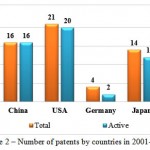 |
Figure 2: Number of patents by countries in 2001-2014. |
As it can be seen from Figure 2, most of the developments in the field of capsule endoscopy are patented in the United States, China and Japan. Slightly lower activity is observed in the Republic of Korea. It should be noted that in China and Republic of Korea all patents are active that demonstrates the importance of proposed solutions and their demand in the market. Lowest patent activity is recorded in Germany and Russia.
88% of selected documents belong to commercial companies, among which the leading place is occupied by the Japanese Olympus Medical Systems Corporation. Among non-profit organizations the leaders areuniversities of China (4 patents), Republic of Korea (2) and Russia (1, not active). This can be explained by the fact that the theme of capsule endoscopy is interesting not only for commercial organizations, but also for young researchers and research teams at universities – that means that the problem is quite relevant and has good potential for a scientific development.
Figure 3 shows the curve of inventive activity (real) in patenting the wireless endoscope capsules and its trend. The trend reflects the positive dynamics of inventive activity in the field of improving the performance of the wireless endoscope capsule.
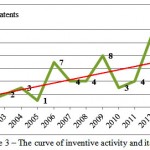 |
Figure 3: The curve of inventive activity and its trend. |
In addition to patent databases thematic search was also conducted by non-patent information retrieval resources: PubMed (http://www.ncbi.nlm.nih.gov/pubmed), Scopus (http://www.scopus.com), Web of Science (http://apps.webofknowledge.com) and DOAJ (http://doaj.org).
The retrospective is 10 years; the search was carried out in all countries.
During the search analytical capabilities of the international citation database Scopus were used.We entered the key phrase “wireless endoscopic capsule”. Analysis of trends in publication activity was conducted by the method of extrapolation of the time series.
Figure 4 shows the statistics by the countries on articles publication devoted to the wireless endoscope capsules. The data obtained from non-patent sources largely coincided with the information extracted from patent databases. All the countries selected for patent search (except Russia), were found among the 12 most active countries in terms of publication activity.
Figure 5 presents the number of articles over the years. The trend of publication activity, as well as inventive activity, shows a positive dynamics.
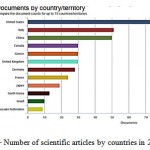 |
Figure 4: Number of scientific articles by countries in 2006-2016. |
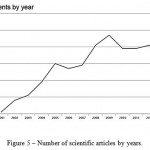 |
Figure 5: Number of scientific articles by years. |
However, during the analysis of patent and non-patent information some differences were revealed. For example, the publication of scientific articles often deal with universities, research institutes or hospitals, on which basis medical studies are conducted (Figure 6). There are virtually none commercial organizations.
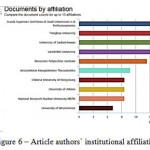 |
Figure 6: Article authors` institutional affiliation. |
Moreover, another peculiarity was defined: in spite of the fact that the patent search showed that in Russia today there is no valid patents and, therefore, Russian scientists are not interested in the field of wireless capsule endoscopy, in fact, active developments are carried out, for example, based on the National Research Nuclear University “MEPhI” (NRNU MEPhI). Non-patent search showed that active developments are performed on the basis of NRNU MEPhI. The scientific group is working on creation of a wireless endoscope capsule “Landish”, which is be highly competitive in functionality with the existing foreign analogues. Several patent application have been filled and a number of scientific articles on capsule endoscopy were published.[23]
Conclusion
The performed thematic patent search showed the inventive activity in the field of the wireless endoscope capsules. It also revealed that during the search it is essential to use both patent and non-patent databases whichcollect current scientific publications, due to the fact that:
research papers are available to the reader almost immediately after they were written (from article submission to paper publication it may take just few weeks), while the publication of the invention description becomes available only eighteen months after the application is filled;
scientific papers can propose a disputable idea that has no evidence yet or objective forms of expression (while for patent protection an invention should meet the statutory patentability criteria), but that can hit other inventors upon the new breakthrough developments;
non-patent publications give more information about the research and scientific components of the invention, show the experimental and testing results as well as the evaluation of the development effectiveness;
non-patent publications allow to quickly get feedback on the work from other researchers and research groups, including foreign ones, for example, in the form of a review.
Thus, the study presented in this paper can be used to facilitate the patent researches in different spheres. Based on developed theoretical statements the patent research on wireless endoscope capsules was carried out. The research can be used during commercialization of the endoscopic capsule developed in the NRNU MEPhI. The results of the study can also be used to conduct patent search on different topics and for other purposes.
In the future, it is planned to describe, classify and systematize the resources that can be used during registration of software and databases.
Acknowledgement
We would like to thank Doctor of Economics, Vice President for Research and International Cooperation of the Russian State Academy of Intellectual Property Smirnova Veronika Removna for her contribution to this study.
This publication is prepared on the results of scientific research project performed by The NRNU MEPhI and JSC RTI as part of the agreement №02.G25.31.0018 on February 12, 2013 between the Joint Stock Company “Radio Engineering Institute named after Academician AL Mints “and the Ministry of Education and Science of the Russian Federation.
References
- Total patent applications (direct and PCT national phase entries). Year Range: 2000 – 2014. Intellectual Property Statistic. WIPO.
- Patent information – key for solving scientific, production and commercial issues. FIPS official website, 2013. URL: http://www1.fips.ru/wps/wcm/connect/content_ru/ru/publishing_activities/key.
- Databases of foreign patent offices. The Federal Service for Intellectual Property (Rospatent), official website, 2013. URL: http://www.rupto.ru/rupto/portal/012046e9-3b8f-11e1-e43a-9c8e9921fb2c.
- Foreign databases. FIPS official website, 2010. URL: http://www1.fips.ru/wps/wcm/connect/content_ru/ru/link_resources/zarub_bd.
- Search and Database of Patent and Trademark Office. HRazvetka. URL: http://hrazvedka.ru/category/bd_pat.
- Likhodedov N.P. Patent information and innovation. Online LLC, St. Petersburg, 2008. URL: http://library.mephi.ru/files/Patentnye%20BD%20i%20osnovnye%20ponyatiya.pdf.
- Patent Search System. Intellogist. Landon IP, Inc, 2009. URL: http://www.intellogist.com/wiki/Compare:Patent_Search_System.
- Skornyakov E.P. Patent Research: uchebn. method. Collec. / E.P. Skornyakov. Moscow: Rospatent, 2006. Pages: 3-47.
- A. Prishchepov, E.M. Sawicki. Guidelines for the identification and registration of applications for inventions and utility models in the field of agriculture. URL: http://www.belpatent.net/stat5.htm.
- P. Skornyakov, M.E. Gorbunova. Patent research. Textbook. Moscow, RGIIS, 2005.
- Trappey, A.J.C., Chin Yuan Fan; Trappey, C.V.; Yi-Liang Lin; Chun-Yi Wu. Intelligent recommendation methodology and system for patent search. 2012 IEEE 16th International Conference on Computer Supported Cooperative Work in Design (CSCWD). Pages: 172 – 178.
CrossRef - Squicciarini, M., Hélène Dernis, & Criscuolo, C. Measuring patent quality: indicators of technological and economic value. Paris: Organisation for Economic Cooperation and Development (OECD). 2013. Retrieved from http://search.proquest.com/docview/1398767703?accountid=168976.
- Sap ag. “Database comparison system and method” in patent application approval process. Computer Weekly News, 558. 2014. Retrieved from http://search.proquest.com/docview/1516553133?accountid=168976.
- Anastasia Tolstaya, Irina Suslina and Polina Tolstaya. Review of Information Databases Providing Data on Current Scientific and Technical Achievements. 2016 Annual International Conference on Biologically Inspired Cognitive Architectures.
CrossRef - Artemyev E.I., Boguslavskiy M.M., Yesterday R.P., Dementiev V.N., Dorkin A.I., Proskuriakov A.V., Ryasentsev V.A., Sysoev P.V. Patenting. Edited by Dr. Jurid. Sciences, Professor V.A. Ryasentseva. The third edition, revised and enlarged. The textbook for higher technical schools. Moscow, Mechanical Engineering, 1984. 352p.
- Hirsch, J. E. An index to quantify an individual’s scientific research output. 15 November 2005. PNAS 102 (46): 16569–16572.
CrossRef - Alexander Kukushkin, Mikhaylov Dmitry, Ekaterina Ivanova, Evgeny Fedorov, Zhukov Igor, Semenov Sergey, Tolstaya Anastasia, Rami Muleys, Starikovski Andrey. Recognition of Hemorrhage in the Images of Wireless Capsule Endoscopy. The 16th IEEE Mediterranean Electrotechnical Conference MELECON 2012. Conference Guide. Pages: 899-902.
CrossRef - Mikhaylov Dmitry, Zhukov Igor, Konev Vladimir, Starikovskiy Andrey, Khabibullin Timur, Tolstaya Anastasia, Kukushkin Alexander. Review of features and metafeatures allowing recognition of abnormalities in the images of GIT. 17th IEEE Mediterranean Electrotechnical Conference (MELECON), 2014. 13-16 April 2014. Pages: 231 – 235.
CrossRef - Dmitry Mikhaylov, Andrey Starikovskiy, Vladimir Konev, Andrey Grigorenko, Larisa Shustova. Review of software for automated analysis of digestive tract images. Biosciences Biotechnology Research Asia, December 2014. Vol. 11(3), p. 1109-1114.
CrossRef - Khabibullin Timur, Anpilogov Artem, Shayakov Askar, Konev Vladimir, Lebedev Grigoriy, Tolstaya Anastasia and Shinkarenko Anton. Magnetically based hardware-software complex for wireless endoscope capsule control. Biosciences Biotechnology Research Asia, Volume No. 12 Issue No.: 2, 2015. Pages: 1273-1280.
- Lebedev G.N., Zharikov E.S., Tolstaya A.M., Tolstaya P.M.Choosing a retention method to control the endoscopic capsule by a magnetic field. Biomedical and Pharmacology Journal, Vol. 13(2), 2016. Pages: 1265-1278.
CrossRef - de Francis, B.S. Lewis, D.S. Mishkin 2012. Capsule endoscopy in understandable language / trans. from English. Ed. E.D. Fedorov, E.V. Ivanova. – M: Practical medicine. – 128 p.: Ills.
- M. Tolstaya, I.V. Suslina, P.M. Tolstaya. The Role of Patent and Non-Patent Databases in Patent Research in Universities. Proceedings of the International scientific-practical conference “Information technologies in education of the XXI century” (ITE-XXI) held on 7 – 8 December 2015 in Moscow, Russia.

This work is licensed under a Creative Commons Attribution 4.0 International License.





